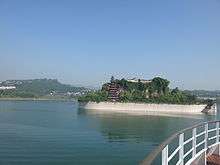Shibaozhai
Shibaozhai (simplified Chinese: 石宝寨; traditional Chinese: 石寶寨; pinyin: shí bǎo zhài; lit.: 'Precious Stone Fortress') is a hill along the bank of the Yangtze River (Chang Jiang) in Zhong County, Chongqing, China. This rocky and craggy hill has extremely steep sides and is about 200 meters (660 feet) tall. On the river side of the hill is a red pavilion which leans against the side of the hill providing a walkway to the temple at the top of the hill. One of the largest wooden temple, red pavilion built at the side of rock and has nine floors. A yellow entrance at the base of the pavilion provides an entrance.


History
At the top of Shibaozhai is a three-storied hall dedicated to Manjusri built during the reign of the Xianfeng Emperor (1850–1861), called the Purple Rain Pavilion. In the year 1819, the nine-story pavilion was constructed adjacent to the cliff to aid people in getting to the top of the hill. Prior to the construction of the pavilion, visitors to the temple were hoisted to the top using a system of chains. In 1956, three more stories were added at the top of the structure.[1] On the top of the pagoda is a Buddhist temple.
Current
At the base of the hill alongside the river bank is a row of merchant stalls which follows the path from the dock to the entrance of the pavilion.
Many river cruise boats dock at Shibaozhai for a few hours to allow passengers to tour the pavilion and temple.
With the construction of the Three Gorges Dam the base of the red pavilion would have been beneath the reservoir's water level.
| Wikimedia Commons has media related to Shibaozhai. |
References
- Xu (2007), 249.
- Bonavia, Judy. (1997). The Yangzi River. Hong Kong: The Guidebook Company.
- Xu Xiaoying, ed. Zhongguo Guta Zaoxing. Beijing: Chinese Forest Press, 2007.